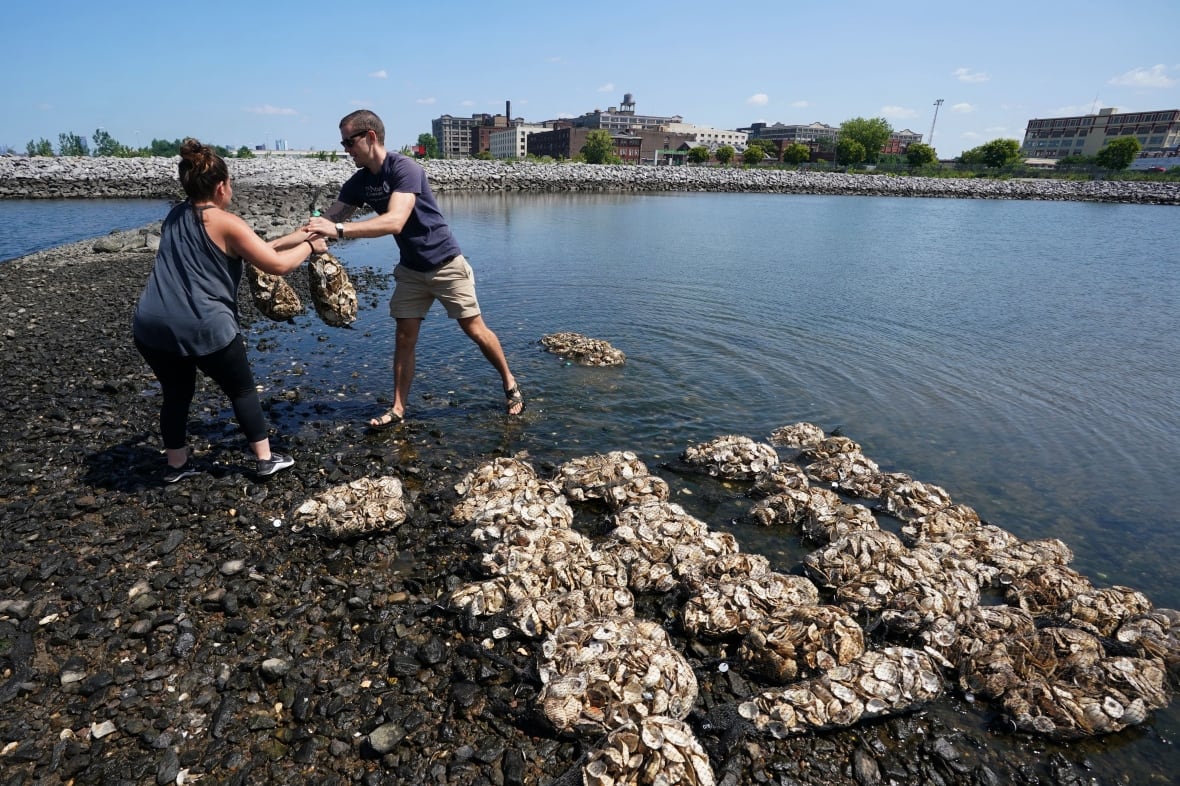Hong Kong created an oyster reef on a seawall beside an airport. Canada could learn from it
Published: 2025-08-02 14:58:22 | Views: 12
Oyster farming has been happening in Hong Kong for hundreds of years. Traditional farming practices, namely harvesting oysters and then putting back hard substrate including shells into the water for oysters to grow on, are one of the reasons oyster populations haven't disappeared completely from the wild.
Now the farms are contributing key knowledge and providing the oysters themselves for restoring natural oyster reefs.
An estimated 85 per cent of the world's oyster reefs have been lost. And the remaining oyster beds in Hong Kong are not recognized by the government as ecologically important, and therefore, not granted protection.
But recent restoration projects are trying to change that, according to Marine Thomas, associate director of conservation for the Nature Conservancy Hong Kong.
Thomas explained that oyster reef restoration is about restoring wild habitats — similar to restoring coral reefs — rather than restoring oyster reefs for consumption.
One reef restoration project in Hong Kong is taking advantage of an unlikely site: off the seawall of Hong Kong International Airport. It used live oysters grown in labs and from local oyster farms to seed the reef. Thomas says it's the first of its kind in the region in trying to establish living reefs along its seawall.
Thomas says oyster reefs can be developed along other seawalls of reclaimed land (this is very common in Hong Kong), if these areas had native oyster reefs before and suitable ecological conditions, which would be applicable to many areas of the Pearl River Delta.
This approach has the potential to be replicated in Canada, too, depending on the location and type of seawall, according to Ramón Filgueira, professor at Dalhousie University's department of marine affairs.
But both Hong Kong and Canada lag behind efforts in the United States, where there is growing awareness of the benefits oyster reefs provide such as increasing fish numbers, regulating water quality and providing coastal protection against erosion from storms.
Not just for shucking
More than a thousand years ago, when Hong Kong was just a collection of small fishing villages, thousands of tonnes per year of oysters were dredged up and whole oyster shells were used in the construction of buildings across the Guangdong region. When shells are burned they turn into lime, the raw material used to make cement. It was this industry, which boomed in the 19th century, that saw almost all wild oyster reefs removed.
While people mostly associate oysters with food, they also fulfil several other functions. Oyster reefs regulate water quality by filtering particles, increase fish populations by providing nursery grounds and the reefs create natural coastal protection against storms and erosion, problems that are set to intensify as a result from climate change.
The United States is leading the way when it comes to oyster reef restoration and enhancement, according to Filgueira, who said there was also a lack of awareness by decision-makers and communities in Canada of the benefits of oyster reefs.

He pointed to the flagship Billion Oyster project in New York, an ambitious rewilding initiative that has planted 150 million larvae in its harbour to improve water quality and to protect shorelines.
While man-made sea walls are being built in Nova Scotia, Filgueira says he believes oyster reefs would be a long term, sustainable complement to those structures that the local community might not be aware of.
"If you look at projects and investment in the U.S., you cannot compare it with the Canadian investment. It's peanuts."
Case in point: In Harris Creek, in Maryland, an oyster reef restoration project cost $29 million US, which is part of a wider project in Chesapeake Bay. Within three years, it was getting more than that back in increased fisheries production — everything from fish to crabs to prawns to other shellfish — which in turn benefits the local fishing community, according to Bayden Russell, associate director of ecology and biodiversity at the University of Hong Kong.
"They're getting over 100 per cent return per year," he said. "It's renewable, every year."

Unlikely oyster reef
One bright spot in Hong Kong is a project in the waters near Hong Kong International Airport. The airport is almost entirely built on reclaimed land, in an area that was once a thriving oyster habitat, according to Thomas. But it was a heavily degraded and challenging environment, she adds. Due to it being a restricted area, it was de facto protected and gave permission for the restoration of an oyster reef.
Last year, recycled concrete was put into the ocean along the 500-metre seawall — since restoring oyster reefs requires reintroducing hard substrate into the ocean for the oysters to latch onto. It was then seeded with native oysters and recycled shells, provided by oyster farmers, as well as larvae grown in the laboratory at the University of Hong Kong.
Teams have been monitoring the new reef to see if the plan to boost oyster populations along the runway is working.
Challenges remain, and Thomas will continue to monitor the reef over the next year, but if all goes to plan, a thriving new reef will emerge.
Russell says that the airport project was exciting because it was a "demonstration that we can actually do this at scale," noting that there used to be at least 750 kilometres of coastline along southern China's Pearl River Delta that had oyster reefs
Oyster reefs belong there: researcher
Beyond that, the notion that oyster reefs can exist in Hong Kong needed to be replanted in people's minds, according to Daniel Pauly, principal investigator of the Sea Around Us project at the University of British Columbia.
"People have to realize that the default setting for a coastline like Hong Kong is to have an oyster reef, and thus rebuilding an oyster reef would be not introducing something new, but rebuilding something that was there before. That belongs there," he said.
Hong Kong is in the process of updating its Biodiversity Strategy and Action Plan, which will outline the priorities for the next decade.
Thomas is advocating for the government to do more to protect the city's coastal marine ecosystems, and expand its marine protected areas to include vulnerable biodiversity hotspots.
"Hong Kong may be a very urbanized area, but it's extremely biodiverse. It is just 0.03 per cent of Chinese waters, and yet, 25 per cent of all marine species recorded [in China] are found in Hong Kong," she said.
Around five per cent of waters are designated as marine parks or marine reserves, which are protected areas under the city's law managed by the Agriculture, Fisheries and Conservation Department. She wants to bring this up to at least 10 per cent, which is still below the global target of 30 per cent.
Source link







